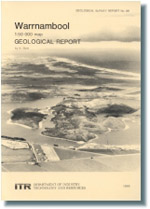GSV Report 86 - Warrnambool 1:50 000 map geological report
 |
| |||||||||||||||||||||||||||||
Product description:Download The downloadable version of this report is supplied in PDF format (24.9MB). Abstract The Warrnambool 1:50 000 map area is located in southwest Victoria. It is characterised by a subdued topography formed by Cainozoic volcanic rocks and young coastal deposits, which contrasts with the Tower Hill maar volcano, the dominant topographic feature. Underlying the area is a thick sequence of Cretaceous to Tertiary sediments. These were deposited in part of the Otway Basin (a basin formed by the separation of Australia and Antarctica) and reflect major depositional cycles. The non-marine Lower Cretaceous Otway Group is the oldest unit intersected in several deep drillholes which dot the area. This is overlain by the largely marine Sherbrook Group, deposited in the Late Cretaceous after marine transgression. The overlying clastic Wangerrip Group was the first group deposited in the Tertiary reflecting another depositional cycle. Carbonate deposition dominated throughout the basin in the middle Tertiary resulting in the Nirranda and Heytesbury groups. At the end of the major depositional cycles the map area stabilised and became an area of karst and soil development. Sea level variations, initiated in the pliocene-pleistocene in response to glaciation resulted in the deposition of dune calcarenites, and beach and swamp material close to the present coastline. Volcanism, beginning in the area at the time of change from clastic to carbonate deposition in the middle Tertiary, is represented by a restricted pyroclastic deposit intersected in the Port Fairy area. More recent phases of volcanism formed lava flows which cover much of the north and northeast of the map area. These have developed soils and are now mainly grazing areas. Younger eruptions, possibly from Mt Rouse (north of the map) formed the lava flow found in the west. This has a stony rise physiography, is less weathered than the older lavas and has developed less soil. The most recent volcanic activity has been the formation of Tower Hill volcano. The ejecta from this eruption blanketed a large area in the central portion of the map. This material breaks down to form soils which are both porous and rich in nutrients and as such is widely cultivated. Non-metallic materials including basalt, tephra and limestone have been extracted from the area for road and other construction. Lime sands are also mined in the area for use as fertilizers. Shallow aquifers, including limestones, fractured basalt and tephra, provide good groundwater for stock and crop irrigation. Deeper aquifers in the Tertiary provide the town water supply for Port Fairy. Bibliographic reference Orth, K., 1988. Warrnambool 1:50 000 map geological report. Geological Survey of Victoria Report 86. Related products:
| ||||||||||||||||||||||||||||||



